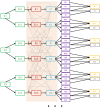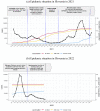Extended compartmental model for modeling COVID-19 epidemic in Slovenia
- PMID: 36209174
- PMCID: PMC9547851
- DOI: 10.1038/s41598-022-21612-7
Extended compartmental model for modeling COVID-19 epidemic in Slovenia
Abstract
In the absence of a systematic approach to epidemiological modeling in Slovenia, various isolated mathematical epidemiological models emerged shortly after the outbreak of the COVID-19 epidemic. We present an epidemiological model adapted to the COVID-19 situation in Slovenia. The standard SEIR model was extended to distinguish between age groups, symptomatic or asymptomatic disease progression, and vaccinated or unvaccinated populations. Evaluation of the model forecasts for 2021 showed the expected behavior of epidemiological modeling: our model adequately predicts the situation up to 4 weeks in advance; the changes in epidemiologic dynamics due to the emergence of a new viral variant in the population or the introduction of new interventions cannot be predicted by the model, but when the new situation is incorporated into the model, the forecasts are again reliable. Comparison with ensemble forecasts for 2022 within the European Covid-19 Forecast Hub showed better performance of our model, which can be explained by a model architecture better adapted to the situation in Slovenia, in particular a refined structure for vaccination, and better parameter tuning enabled by the more comprehensive data for Slovenia. Our model proved to be flexible, agile, and, despite the limitations of its compartmental structure, heterogeneous enough to provide reasonable and prompt short-term forecasts and possible scenarios for various public health strategies. The model has been fully operational on a daily basis since April 2020, served as one of the models for decision-making during the COVID-19 epidemic in Slovenia, and is part of the European Covid-19 Forecast Hub.
© 2022. The Author(s).
Conflict of interest statement
The authors declare no competing interests.
Figures






Similar articles
-
Predictive performance of multi-model ensemble forecasts of COVID-19 across European nations.Elife. 2023 Apr 21;12:e81916. doi: 10.7554/eLife.81916. Elife. 2023. PMID: 37083521 Free PMC article.
-
An ensemble n -sub-epidemic modeling framework for short-term forecasting epidemic trajectories: Application to the COVID-19 pandemic in the USA.medRxiv [Preprint]. 2022 Jun 21:2022.06.19.22276608. doi: 10.1101/2022.06.19.22276608. medRxiv. 2022. Update in: PLoS Comput Biol. 2022 Oct 6;18(10):e1010602. doi: 10.1371/journal.pcbi.1010602. PMID: 35794886 Free PMC article. Updated. Preprint.
-
SpatialWavePredict: a tutorial-based primer and toolbox for forecasting growth trajectories using the ensemble spatial wave sub-epidemic modeling framework.BMC Med Res Methodol. 2024 Jun 7;24(1):131. doi: 10.1186/s12874-024-02241-2. BMC Med Res Methodol. 2024. PMID: 38849766 Free PMC article.
-
Compartmental structures used in modeling COVID-19: a scoping review.Infect Dis Poverty. 2022 Jun 21;11(1):72. doi: 10.1186/s40249-022-01001-y. Infect Dis Poverty. 2022. PMID: 35729655 Free PMC article.
-
Investigating and forecasting infectious disease dynamics using epidemiological and molecular surveillance data.Phys Life Rev. 2024 Dec;51:294-327. doi: 10.1016/j.plrev.2024.10.011. Epub 2024 Oct 24. Phys Life Rev. 2024. PMID: 39488136 Review.
Cited by
-
A deterministic compartmental model for the transition between variants in the spread of Covid-19 in Italy.PLoS One. 2023 Nov 14;18(11):e0293416. doi: 10.1371/journal.pone.0293416. eCollection 2023. PLoS One. 2023. PMID: 37963148 Free PMC article.
-
Enhancing COVID-19 forecasting precision through the integration of compartmental models, machine learning and variants.Sci Rep. 2024 Aug 19;14(1):19220. doi: 10.1038/s41598-024-69660-5. Sci Rep. 2024. PMID: 39160264 Free PMC article.
References
-
- World Health Organization. Coronavirus disease (COVID-19) Pandemic. 2022 (accessed 26 Mar 2022); https://www.who.int/emergencies/diseases/novel-coronavirus-2019/.
-
- COVID-19-sledilnik. 2020 (accessed 26 March 2022); https://covid-19.sledilnik.org/.
-
- Keeling, M. J., Rohani, P. Modeling Infectious Diseases in Humans and Animals. (Princeton University Press, 2008, accessed 26 March 2022); 10.1515/9781400841035/html.
-
- Leskovar M, Cizelj L. Robust and intuitive model for COVID-19 epidemic in Slovenia. Stroj. vestn. J. Mech. Eng. 2022;68:213–224. doi: 10.5545/sv-jme.2022.50. - DOI
Publication types
MeSH terms
LinkOut - more resources
Full Text Sources
Medical
Miscellaneous

